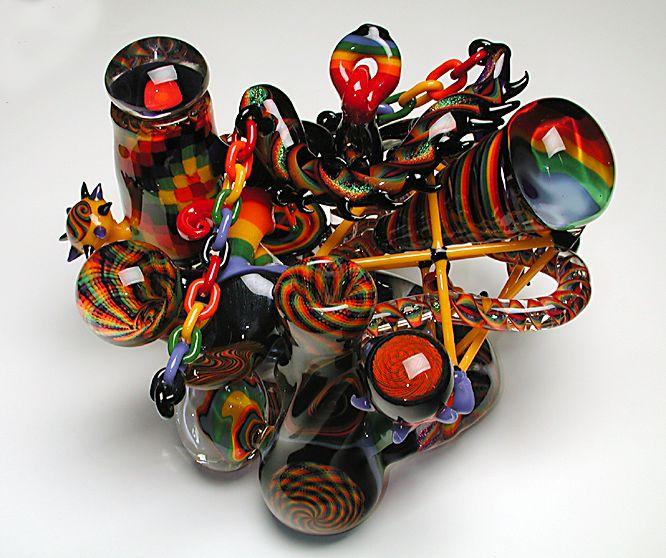A bong is a device that uses water to make rips much smoother by filtering and cooling the smoke. A bong works by creating a vacuum-like airtight design that forces smoke to bubble and diffuse as it travels through water. When the user lights up the bowl and inhales, the smoke is sucked from the bowl and stored in the chamber.
Bongs are one of the most common forms of consuming herbs or tobacco, especially dried flower. They have been around for centuries and have been used by different cultures around the world. The word bong is said to have come from the Thai word “baung” for a bamboo tube used for smoking weed. Today’s bongs look a lot more complicated than a simple bamboo tube, but they all come down to the same basic process.
The Anatomy of a Bong
A standard bong can be broken down into five basic parts:
-
Bowl
: The bowl is the bulbous attachment where dried herb or tobacco is loaded and combusted. It’s often removable, allowing it to function as pull- or slide-carburetor. -
Carb
: The carb, short for carburetor, is a small hole that allows the user to clear smoke from the entire chamber of the bong, completing the bong toke. The most common type of carb found on glass bongs is a pull- or slide-carb, which is exposed when the bowl is removed. -
Downstem
: The downstem is the small tube that allows the smoke to travel from the bowl down to the base, where it then percolates through water. -
Base
: The base is the bottom of a bong and can take many shapes, depending on style. A bubble- or beaker-shaped base is often used to create the water chamber in which the smoke cools as it passes through the water. -
Tube
: The tube is the main part of the bong that ends with the mouthpiece. It can be straight, angled, or curved, and may contain additional features such as ice pinches, splash guards, or percolators.
The Benefits of Using a Bong
Many users prefer using a bong over other methods of smoking because of its advantages, such as:
-
Smoother smoke
: The water in a bong eliminates the dry heat you get from a joint or a pipe. The effect is often described as being cooler, creamy, and smooth rather than harsh. This makes it easier to take larger hits and enjoy the full flavor of your herb or tobacco. -
Filtration
: The water in a bong also helps to filter out some of the tar and ash that would otherwise end up in your lungs. This reduces some of the health risks associated with smoking and makes for a cleaner experience. -
Variety
: Bongs come in all shapes and sizes, and can be made from different materials such as glass, ceramic, metal, wood, or plastic. Some bongs are simple and functional, while others are artistic and elaborate. You can choose a bong that suits your personal style and preference. -
Fun
: Bongs are also fun to use, especially with friends. You can share a bong with your buddies and enjoy passing it around. You can also experiment with different types of water, ice, or additives to enhance your smoking session.
The Risks of Using a Bong
While using a bong may have some benefits over other smoking methods, it’s not without its drawbacks. Some of the risks of using a bong include:
-
Lung damage
: Smoking anything can harm your lungs, regardless of what you’re smoking or how you’re smoking it. Smoke contains carcinogens and other harmful substances that can irritate your lung tissues and cause scarring and damage to your small blood vessels. Smoking also increases your risk of developing chronic bronchitis, emphysema, and lung cancer. -
Overconsumption
: Bongs make it easy to overdo it when smoking, especially if you’re not used to them. The smoother smoke can mask the potency of your herb or tobacco, and the larger hits can deliver more THC or nicotine than you intended. This can lead to unpleasant effects such as coughing, nausea, dizziness, paranoia, or anxiety. -
Bacterial growth
: Bongs need to be cleaned regularly to prevent the buildup of mold, bacteria, and other microorganisms that can grow in the water and on the surfaces of the bong. These can contaminate your smoke and cause infections or illnesses. You should also avoid sharing a bong with others, especially if you or they are sick. -
Plastic toxicity
: If you’re using a plastic bong, you should be aware of the potential dangers of heating and inhaling plastic. Plastics that contain chemicals like BPA and phthalates have been linked to adverse health effects, including cancer. You should avoid using plastic bongs that are not designed for smoking, such as soda bottles or watermelons.
How to Use a Bong
Using a bong is fairly simple, but there are some steps you should follow to ensure a smooth and enjoyable experience. Here’s how to use a bong:
-
Fill the bong with water
: Pour enough water into the base of the bong to cover the bottom of the downstem. The water level should be high enough to create bubbles when you inhale, but not so high that it splashes into the tube or your mouth. You can also add ice cubes or other additives to the water for extra cooling or flavor. -
Grind your herb or tobacco
: Use a grinder or your fingers to break down your herb or tobacco into small pieces. This will help it burn more evenly and efficiently in the bowl. -
Pack the bowl
: Take a pinch of your ground herb or tobacco and place it into the bowl. Don’t pack it too tightly or too loosely, as this can affect the airflow and the burning rate. You want to leave some space for air to pass through. -
Light the bowl
: Hold the bong in one hand and use a lighter or a hemp wick to ignite the herb or tobacco in the bowl. As you do this, place your mouth over the mouthpiece and start inhaling slowly and gently. -
Inhale the smoke
: As you inhale, you’ll see the smoke travel from the bowl through the downstem and into the water, where it will bubble and cool down. The smoke will then rise up through the tube and into your mouth. You can inhale as much or as little as you want, depending on your tolerance and preference. -
Clear the chamber
: When you’re ready to finish your hit, remove the bowl from the bong (if it’s removable) or uncover the carb hole (if it has one) and inhale sharply to clear the remaining smoke from the chamber. Hold the smoke in your lungs for a few seconds before exhaling. -
Repeat as desired
: You can take as many hits as you want from a bong, until you feel satisfied or until the bowl is empty. If you’re smoking with others, pass the bong to the next person after clearing your hit. -
Clean the bong
: After using a bong, you should empty the water and rinse it with hot water. You should also clean it thoroughly with alcohol and salt every once in a while to remove any residue or buildup.
Conclusion
A bong is a popular way of smoking herbs or tobacco that offers a smoother and cooler smoke than other methods. A bong works by using water to filter and cool down the smoke as it travels through a series of chambers. A bong consists of five basic parts: a bowl, a carb, a downstem, a base, and a tube. Using a bong is easy, but it also comes with some risks that you should be aware of. Bongs can damage your lungs, cause overconsumption, harbor bacteria, and release toxins if not used properly. You should always use a clean bong with fresh water and quality herb or tobacco for the best experience.





